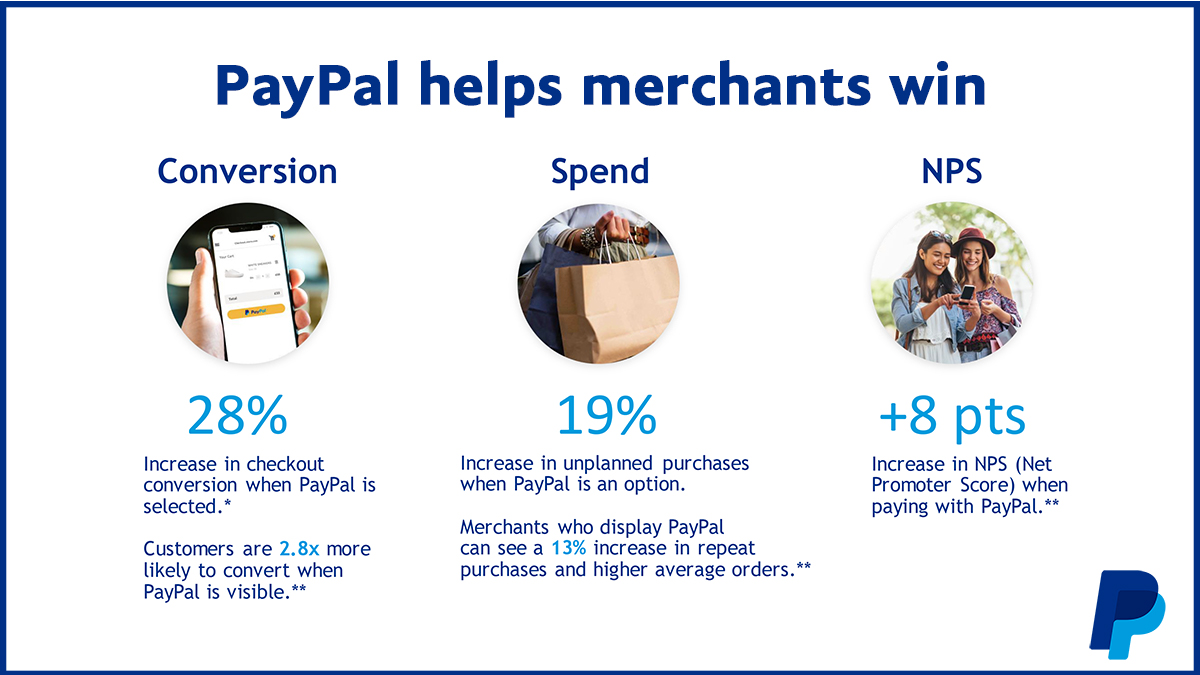PayPal Increases Conversion, Average Order Value and Net Promoter Score for Merchants
ProductPayPalResearch and Insights
January 14, 2021 | Marcy Campbell, VP and GM North America, Australia Sales & Global Sales Ops at PayPal
To demonstrate the impact of a well optimized conversion strategy, PayPal commissioned Nielsen to measure the impact that PayPal has for U.S. based merchants across 10 verticals including 73 of the top 100 merchants, according to Digital Commerce 360 Top 1,0001. The research analyzed purchase behaviors from more than 15,000 online shoppers and surveyed more than 2,800 consumers to hone in on three crucial dimensions including conversion, spend and merchant experience, calculated by Net Promoter Score (NPS).

PayPal users are more likely to convert where PayPal is visible
The findings show that PayPal’s customers convert 2.8x more when shopping with merchants who accept PayPal when viewed across the entire customer experience. Further, starting at the point of purchase, PayPal converts 28% higher at checkout*, when compared to other payment methods.
For merchants in verticals with big ticket items, these numbers are even higher when checking out with PayPal. For example, electronics and entertainment convert at checkout 90% and 62% higher, respectively. This extends to first time visitors to a merchant's site. First time visitors in the health & beauty vertical are 12% more likely to make a purchase when PayPal is presented and 7% more likely in the gaming vertical.
These increases in conversion demonstrate the influence of trust and credibility on a consumer's spending patterns.
PayPal results in higher average orders
In addition to a completed purchase, consumers’ average order values increase when paying with PayPal compared to other payment methods:
- When making health & beauty purchases, consumers are likely to spend $64 more when paying with PayPal. The increase in spend is also significantly higher with electronics and entertainment & leisure, which show a $30 and $25 increase in average order value, respectively.
- Consumers are 52% more likely to complete an unplanned purchase when using PayPal for food delivery and quick service restaurants (QSR), compared to non-PayPal payment methods.
PayPal drives repeat purchases
The benefits of using PayPal expand to repeat purchases, resulting in the creation of customer loyalty:
- When checking out with PayPal, consumers are 13% more likely to make a repeat purchase from the same merchant.
- When examined by vertical, grocery saw a 20% increase in repeat purchases and gaming merchants saw a 15% increase in repeat purchases.
Just as important as acquiring a new customer is the ability to retain existing customers and build a long-term relationship. Acquiring a new customer is anywhere from five to 25 times more expensive than retaining an existing one2. By creating a simple and seamless checkout experience, customers are more likely to keep coming back and make repeat purchases.
An all-around better customer experience: higher NPS
Net Promoter Scores are an important success metric used by at least two-thirds of the Fortune 1000 to measure customer loyalty, including most or all of the financial service companies, airlines, telecom companies, retailers, and others3. The data shows that paying with PayPal leads to an increase in NPS by an average of 8 points. This number increases significantly in the health & beauty vertical, which showed an 18-point increase in NPS, and grocery, which resulted in a 11-point increase in NPS.
Conversion rates are one of the most important metrics for merchants small and large. They are also one of the most challenging aspects of the ecommerce experience for merchants to manage and master. In addition to having a direct impact on revenue, purchase conversion has a correlation to customer trust, loyalty and the likelihood of repeat purchases. But the conversion process starts long before the customer even reaches the checkout page. It’s the culmination of a positive customer experience, and something that everyone from the CMO, to the CFO, to the CEO needs to prioritize.
Using PayPal results in higher conversion, higher average order values, an increase in repeat transactions and NPS. All of which contribute to a more seamless checkout process and customer experience.
*This research supplements insights from comScore in 2018 that explored PayPal Checkout conversion. It is worth noting the difference in the two studies – where comScore uncovered checkout conversion starting when a user clicks on a payment type, Nielsen’s data looks at the full spectrum, examining both conversion from the moment a customer enters a merchant’s site, to the final confirmed purchase page, and conversion starting at checkout through final confirmed purchase page.
Sources: Nielsen behavioral panel of over 15,000 online U.S. consumers and over 99,000 transactions over a 3-month period (July 2020– September 2020). Nielsen attitudinal data surveyed 3rd party panel who made an online purchase over a 2-week span for 2,800 consumers (1,400 PayPal users and 1,400 consumers who used a different payment method including digital wallets, Buy Now Pay Later solutions and credit/debit/prepaid cards) during June 2020.
1https://www.digitalcommerce360.com/product/top-1000-database/
2https://hbr.org/2014/10/the-value-of-keeping-the-right-customers
3Fortune, The simple metric that’s taking over big business, Geoff Colvin, May 18, 2020